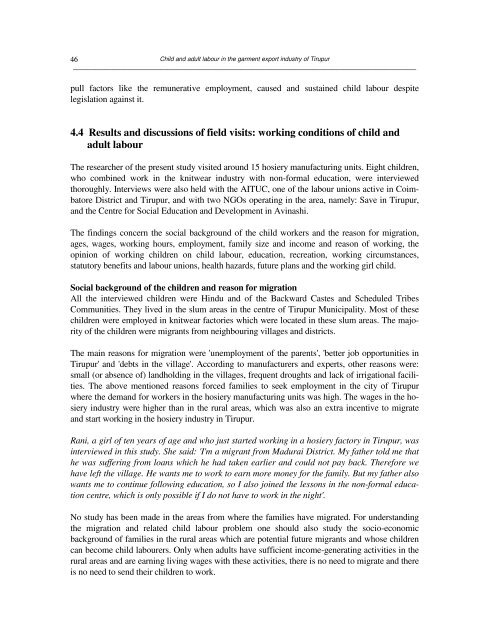You also want an ePaper? Increase the reach of your titles
YUMPU automatically turns print PDFs into web optimized ePapers that Google loves.
46<br />
<strong>Child</strong> <strong>and</strong> <strong>adult</strong> <strong>labour</strong> <strong>in</strong> <strong>the</strong> <strong>garment</strong> <strong>export</strong> <strong>in</strong>dustry <strong>of</strong> Tirupur<br />
──────────────────────────────────────────────────────────────────────────────────────────────<br />
pull factors like <strong>the</strong> remunerative employment, caused <strong>and</strong> susta<strong>in</strong>ed child <strong>labour</strong> despite<br />
legislation aga<strong>in</strong>st it.<br />
4.4 Results <strong>and</strong> discussions <strong>of</strong> field visits: work<strong>in</strong>g conditions <strong>of</strong> child <strong>and</strong><br />
<strong>adult</strong> <strong>labour</strong><br />
The researcher <strong>of</strong> <strong>the</strong> present study visited around 15 hosiery manufactur<strong>in</strong>g units. Eight children,<br />
who comb<strong>in</strong>ed work <strong>in</strong> <strong>the</strong> knitwear <strong>in</strong>dustry with non-formal education, were <strong>in</strong>terviewed<br />
thoroughly. Interviews were also held with <strong>the</strong> AITUC, one <strong>of</strong> <strong>the</strong> <strong>labour</strong> unions active <strong>in</strong> Coimbatore<br />
District <strong>and</strong> Tirupur, <strong>and</strong> with two NGOs operat<strong>in</strong>g <strong>in</strong> <strong>the</strong> area, namely: Save <strong>in</strong> Tirupur,<br />
<strong>and</strong> <strong>the</strong> Centre for Social Education <strong>and</strong> Development <strong>in</strong> Av<strong>in</strong>ashi.<br />
The f<strong>in</strong>d<strong>in</strong>gs concern <strong>the</strong> social background <strong>of</strong> <strong>the</strong> child workers <strong>and</strong> <strong>the</strong> reason for migration,<br />
ages, wages, work<strong>in</strong>g hours, employment, family size <strong>and</strong> <strong>in</strong>come <strong>and</strong> reason <strong>of</strong> work<strong>in</strong>g, <strong>the</strong><br />
op<strong>in</strong>ion <strong>of</strong> work<strong>in</strong>g children on child <strong>labour</strong>, education, recreation, work<strong>in</strong>g circumstances,<br />
statutory benefits <strong>and</strong> <strong>labour</strong> unions, health hazards, future plans <strong>and</strong> <strong>the</strong> work<strong>in</strong>g girl child.<br />
Social background <strong>of</strong> <strong>the</strong> children <strong>and</strong> reason for migration<br />
All <strong>the</strong> <strong>in</strong>terviewed children were H<strong>in</strong>du <strong>and</strong> <strong>of</strong> <strong>the</strong> Backward Castes <strong>and</strong> Scheduled Tribes<br />
Communities. They lived <strong>in</strong> <strong>the</strong> slum areas <strong>in</strong> <strong>the</strong> centre <strong>of</strong> Tirupur Municipality. Most <strong>of</strong> <strong>the</strong>se<br />
children were employed <strong>in</strong> knitwear factories which were located <strong>in</strong> <strong>the</strong>se slum areas. The majority<br />
<strong>of</strong> <strong>the</strong> children were migrants from neighbour<strong>in</strong>g villages <strong>and</strong> districts.<br />
The ma<strong>in</strong> reasons for migration were 'unemployment <strong>of</strong> <strong>the</strong> parents', 'better job opportunities <strong>in</strong><br />
Tirupur' <strong>and</strong> 'debts <strong>in</strong> <strong>the</strong> village'. Accord<strong>in</strong>g to manufacturers <strong>and</strong> experts, o<strong>the</strong>r reasons were:<br />
small (or absence <strong>of</strong>) l<strong>and</strong>hold<strong>in</strong>g <strong>in</strong> <strong>the</strong> villages, frequent droughts <strong>and</strong> lack <strong>of</strong> irrigational facilities.<br />
The above mentioned reasons forced families to seek employment <strong>in</strong> <strong>the</strong> city <strong>of</strong> Tirupur<br />
where <strong>the</strong> dem<strong>and</strong> for workers <strong>in</strong> <strong>the</strong> hosiery manufactur<strong>in</strong>g units was high. The wages <strong>in</strong> <strong>the</strong> hosiery<br />
<strong>in</strong>dustry were higher than <strong>in</strong> <strong>the</strong> rural areas, which was also an extra <strong>in</strong>centive to migrate<br />
<strong>and</strong> start work<strong>in</strong>g <strong>in</strong> <strong>the</strong> hosiery <strong>in</strong>dustry <strong>in</strong> Tirupur.<br />
Rani, a girl <strong>of</strong> ten years <strong>of</strong> age <strong>and</strong> who just started work<strong>in</strong>g <strong>in</strong> a hosiery factory <strong>in</strong> Tirupur, was<br />
<strong>in</strong>terviewed <strong>in</strong> this study. She said: 'I'm a migrant from Madurai District. My fa<strong>the</strong>r told me that<br />
he was suffer<strong>in</strong>g from loans which he had taken earlier <strong>and</strong> could not pay back. Therefore we<br />
have left <strong>the</strong> village. He wants me to work to earn more money for <strong>the</strong> family. But my fa<strong>the</strong>r also<br />
wants me to cont<strong>in</strong>ue follow<strong>in</strong>g education, so I also jo<strong>in</strong>ed <strong>the</strong> lessons <strong>in</strong> <strong>the</strong> non-formal education<br />
centre, which is only possible if I do not have to work <strong>in</strong> <strong>the</strong> night'.<br />
No study has been made <strong>in</strong> <strong>the</strong> areas from where <strong>the</strong> families have migrated. For underst<strong>and</strong><strong>in</strong>g<br />
<strong>the</strong> migration <strong>and</strong> related child <strong>labour</strong> problem one should also study <strong>the</strong> socio-economic<br />
background <strong>of</strong> families <strong>in</strong> <strong>the</strong> rural areas which are potential future migrants <strong>and</strong> whose children<br />
can become child <strong>labour</strong>ers. Only when <strong>adult</strong>s have sufficient <strong>in</strong>come-generat<strong>in</strong>g activities <strong>in</strong> <strong>the</strong><br />
rural areas <strong>and</strong> are earn<strong>in</strong>g liv<strong>in</strong>g wages with <strong>the</strong>se activities, <strong>the</strong>re is no need to migrate <strong>and</strong> <strong>the</strong>re<br />
is no need to send <strong>the</strong>ir children to work.


















